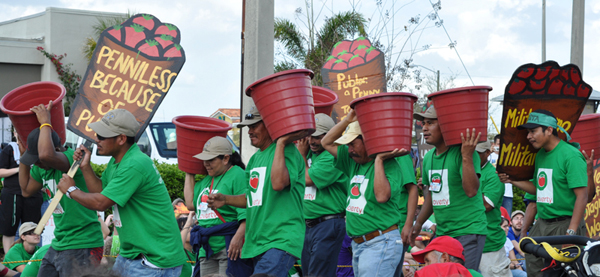Organizing for Workplace Safety in the Face of a Hostile State

The Coalition of Immokalee Workers has become the most successful farmworkers union since the heyday of the United Farm Workers in the late 60s and early 70s (before Cesar Chavez decided to purge anyone opposed to his dictatorial leadership). They have done so in the Florida tomato fields in the face of openly hostility from the state, something that certainly hasn’t improved over time under such fine governors as Rick Scott and Ron DeSantis. And yet, as this excellent Washington Post article demonstrates, the CIW has created the best regulations around heat exposure in any workplace in this country. They’ve done so through a combination of intensive internal organizing and making it in the interests of the tomato growers to comply, as well as fast food chains and grocery stores who buy their tomatoes from these farms. Read the whole thing, but here’s an excerpt:
But unlike at many other farms, every worker takes a 10-minute break every two hours during the hottest part of the year. When they feel the effects of heat illness coming on, they have the right to cool down in the shade. Sunripe Certified Brands, the company that owns the farm, must provide clean water, shaded rest areas and nearby bathrooms for all of its workers.
These are the strongest set of workplace heat protections in the United States. They were not put in place by local, state or federal regulators, but by the workers who spent years organizing to push companies to adopt them.
Created in 2011 by the Coalition of Immokalee Workers, a nonprofit that represents farmworkers, the Fair Food Program (FFP) certifies farms that follow a strict set of workplace safety rules. In exchange, participating farms are first in line to sell their wares to 14 big produce buyers that include Walmart, Trader Joe’s, Whole Foods and McDonald’s.
The buyers agree to pay a small premium for produce from farms where workers are protected and blacklist farms that get kicked out of the program. In exchange, they can tout their ethical practices, a selling point with a growing number of consumers worried about who produces their food.
Heat stress kills dozens of workers and sickens thousands more each year, according to the Labor Department, a toll that’s likely to rise as climate change makes dangerously hot days more common. Last year was the hottest on record, and forecasters are predicting that this year will top it.
But so far, efforts to protect farmworkers from heat have been limited. There are no federal workplace heat safety rules, although the Labor Department is slowly working to create some. Only four states — California, Washington, Oregon and Colorado — have heat rules that apply to farmworkers.
In November, a push to create heat regulations for farm and construction workers in Miami-Dade County stalled because commissioners worried the rules “could potentially kill industry.”
But at a time when companies are resisting government efforts to regulate heat safety, the FFP has convinced many businesses to voluntarily follow even stricter standards.
“Farm owners have to comply because the risk of losing clients if they don’t treat workers well is so great that it can put them in a very difficult position relative to their competitors in the industry,” said Gerardo Reyes Chávez, a leader in the Coalition of Immokalee Workers.
So far, dozens of farms in 10 states have joined the program, protecting 20,000 workers. At least 30 more farms, from an additional 11 states, applied to join this year after the Agriculture Department began offering up to $2 million in subsidies to farms that follow safe labor standards and participate in worker-led monitoring programs like the FFP.
Workers in other industries have created their own versions of the FFP model, including dairy workers in Vermont, fishers in Britain and a new organization of poultry workers in Arkansas.
The whole thing is a remarkable story of organizing in the face of extremely difficult conditions, winning, and saving workers’ lives. And this is 100% the result of worker organizing. It’s one of the few absolutely unmitigated success stories in the contemporary labor movement. There’s really so much to learn here and it can be applied in other places, as we are seeing. Yes, it’s inefficient and much more work than the government coming in and setting regulations. But when the government isn’t going to do that, it can be a central tenet of worker organizing. It takes a different kind of unionism than what has developed in the U.S. For some people, that return to a more 19th century version of unionism at the point of production is desirable. I don’t agree really, but you can see the point when you see victories like this.


